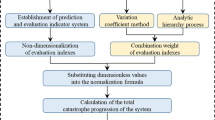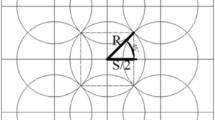Abstract
With the increasing depth of underground engineering, the risk of coal–rock dynamic disasters such as rockburst is becoming more and more serious and complex, which seriously threatens the safety of coal resource, mine production and the surface ecological environment. However, the existing risk indices and methods used for evaluating rockburst risk cannot be fully applied to deep goal seam group (DCG) mining. For the safe exploitation of coal resources, in this paper, based on statistical analyses of 300 cases of rockburst, six new indices are proposed for evaluating rockburst risk in the DCG, namely dip angle, moisture content, stability of coal seam, advancing speed of working face, disturbance factors and support patterns. In addition, the influence of multiple factors coupling and superposition on rockburst risk was considered. Thus, the Comprehensive Index Method of rockburst risk of Deep Coal seam Group (DCG–CIM) based on analytic hierarchy process was established. Finally, rockburst risk in the evaluation area was quantitatively assessed into four grades, including “No rockburst risk”, “Weak rockburst risk”, “Medium rockburst risk” and “Strong rockburst risk”. Taking the 2233 working face of Hengda Coalmine as an example, the evaluation results show that the ranges of 0–184 m, 224–284 m, 324–384 m, 424–484 m, 524–584 m and 594–624 m from terminal line of haulage roadway on 2233 working face were the medium rockburst risk zones, which are in accordance with the on-site impact damage results and are more accurate than the traditional method. The DCG–CIM can consider more inducing factors and obtain more accurate and reliable evaluation results and is more suitable for deep coal seam group mining.










Similar content being viewed by others

References
Adoko, A. C., Gokceoglu, C., Wu, L., & Zuo, Q. J. (2013). Knowledge-based and data-driven fuzzy modeling for rock burst prediction. International Journal of Rock Mechanics and Mining Sciences, 61, 86–95.
Afraei, S., Shahriar, K., & Madani, S. H. (2018). Statistical assessment of rock burst potential and contributions of considered predictor variables in the task. Tunnelling and Underground Space Technology, 72, 250–271.
Bräuner, G. (2017). Rock bursts in coal mines and their prevention. London: Routledge.
Cai, W., Dou, L., Zhang, M., Cao, W., Shi, J. Q., & Feng, L. (2018). A fuzzy comprehensive evaluation methodology for rock burst forecasting using microseismic monitoring. Tunnelling and Underground Space Technology, 80, 232–245.
Cheng, Z., Liu, B., Zou, Q., Wang, X., Feng, J., Zhao, Z., & Sun, F. (2020). Analysis of spatial-temporal evolution of mining-induced fracture field: A case study using image processing in the Shaqu coal mine, China. Natural Resources Research, 29(3), 1601–1615.
Dou, L. M., & He, X. Q. (2001). Theory and technology of rock burst prevention (pp. 35–39). Xuzhou: China University of Mining and Technology Press.
Dou, L. M., & He, X. Q. (2004). Model for rock burst failure and its critical values of acoustic and electromagnetic emission. Journal-China University of Mining and Technology (Chinese edition), 33, 504–508.
Dou, L., Chen, T., Gong, S., He, H., & Zhang, S. (2012). Rock burst hazard determination by using computed tomography technology in deep workface. Safety Science, 50, 736–740.
Diederichs, M. S. (2018). Early assessment of dynamic rupture hazard for rockburst risk management in deep tunnel projects. Journal of the Southern African Institute of Mining and Metallurgy, 118(3), 193–204.
Feng, X. T., Xiao, Y. S., & Feng, G. L. (2012). Mechanism, warning and dynamic control of rock burst evolution process. In: ISRM Regional Symposium-7th Asian Rock Mechanics Symposium. International Society for Rock Mechanics and Rock Engineering.
Feng, X., & Zhang, Q. (2018). The effect of backfilling materials on the deformation of coal and rock strata containing multiple goaf: A numerical study. Minerals, 8, 224.
Feng, X., Zhang, Q., Wang, E., Ali, M., & Zhang, G. (2020). 3d modeling of the influence of a splay fault on controlling the propagation of nonlinear stress waves induced by blast loading. Soil Dynamics and Earthquake Engineering, 138, 106335.
Hoek, E., Kaiser, P. K., & Bawden, W. F. (2000). Support of underground excavations in hard rock. Boca Raton: CRC Press.
He, X., Chen, W., Nie, B., & Zhang, M. (2010). Classification technique for danger classes of coal and gas outburst in deep coal mines. Safety Science, 48, 173–178.
He, M., Zhao, F., Cai, M., & Du, S. (2015). A novel experimental technique to simulate pillar burst in laboratory. Rock Mechanics and Rock Engineering, 48, 1833–1848.
Huang, B., Wang, Y., & Cao, S. (2015). Cavability control by hydraulic fracturing for top coal caving in hard thick coal seams. International Journal of Rock Mechanics and Mining Sciences, 74, 45–57.
He, J., Dou, L., Gong, S., Li, J., & Ma, Z. (2017). Rock burst assessment and prediction by dynamic and static stress analysis based on micro-seismic monitoring. International Journal of Rock Mechanics and Mining Sciences, 100, 46–53.
Hussain, R., & Luo, K. (2020). Geochemical evaluation of enrichment of rare-earth and critical elements in coal wastes from Jurassic and Permo-carboniferous coals in Ordos Basin, China. Natural Resources Research, 29, 1731–1754.
Jiang, F., Feng, Y., & Liu, Y. (2014). Dynamic evaluation method for rock burst risk before stopping. Chinese Journal of Rock Mechanics and Engineering, 33, 2101–2106.
Kong, X., Wang, E., Li, S., Lin, H., & Ju, Y. (2019). Dynamic mechanical characteristics and fracture mechanism of gas-bearing coal based on SHPB experiments. Theoretical and Applied Fracture Mechanics, 105, 102395.
Li, T., Cai, M., & Cai, M. (2007). A review of mining-induced seismicity in China. International Journal of Rock Mechanics and Mining Sciences, 44, 1149–1171.
Li, X., Wang, E., Li, Z., Liu, Z., Song, D., & Qiu, L. (2016). Rock burst monitoring by integrated micro-seismic and electromagnetic radiation methods. Rock Mechanics and Rock Engineering, 49, 4393–4406.
Liu, X., Xu, G., Zhang, C., Kong, B., Qian, J., Zhu, D., & Wei, M. (2017). Time effect of water injection on the mechanical properties of coal and its application in rock burst prevention in mining. Energies, 10(11), 1783.
Liu, X., & Wang, E. (2018). Study on characteristics of EMR signals induced from fracture of rock samples and their application in rock burst prediction in copper mine. Journal of Geophysics and Engineering, 15, 909–920.
Li, Z. L., He, X. Q., Dou, L. M., & Song, D. Z. (2018). Comparison of rock burst occurrence during extraction of thick coal seams using top-coal caving versus slicing mining methods. Canadian Geotechnical Journal, 55, 1433–1450.
Liu, Z., Cao, A., Guo, X., & Li, J. (2018). Deep-hole water injection technology of strong impact tendency coal seam—a case study in Tangkou coal mine. Arabian Journal of Geosciences, 11, 12.
Li, M., Zhang, J., An, B., Germain, D., & Xu, Q. (2019). Effect of cyclic lateral loading on the compaction behaviour of waste rock backfill materials in coal mines. Energies, 12(1), 17.
Mao, X., Chen, Z., Xu, S., & Li, T. (2001). Experimental study on the relation between the burst tendency and water content in coal seam. Chinese Journal of Rock Mechanics and Engineering, 20, 49–52.
Pan, Y. S., & Xie, L. M. (2012). Experimental investigation on temperature of drilling cuttings to predict rock burst. Chinese Journal of Geotechnical Engineering, 12, 2822–2832.
Qiu, L., Song, D., He, X. Q., Wang, E., Li, Z. H. L., Yin, S., et al. (2020). Multifractal of electromagnetic waveform and spectrum about coal rock samples subjected to uniaxial compression. Fractals., 28, 2050061.
Shen, W., Dou, L. Z., He, H., & Zhu, G. A. (2017). Rock burst assessment in multi-seam mining: a case study. Arabian Journal of Geosciences, 10, 196.
Song, D., Wang, E., Li, Z., Qiu, L., & Xu, Z. (2017). EMR: An effective method for monitoring and warning of rock burst hazard. Geomechanics and Engineering, 12, 53–69.
Song, D., Wang, E., He, X., Jia, H., Qiu, L., Chen, P., & Wang, S. (2018). Use of electromagnetic radiation from fractures for mining-induced stress field assessment. Journal of Geophysics and Engineering, 15, 1093–1103.
Tang, J. X., Kang, Q. R., & Yang, G. Z. (2010). Application of improved FHAP in mining-disturbed slope stability evaluation. Disaster Advances, 3, 424–427.
Wang, E. Y., He, X. Q., Dou, L. M., Zhou, S. N., Nie, B. S., & Liu, Z. T. (2005). Electromagnetic radiation characteristics of coal and rocks during excavation in coal mine and their application. Chinese Journal of Geophysics, 48, 216–221.
Wang, C. (2011). Research of rock burst risk comprehensive evaluation method based on unascertained measurement model and application. Dissertation, China University of Mining and Technology.
Wang, P., Jiang, L. S., Zheng, P. Q., Qin, G. P., & Zhang, C. (2019). Inducing mode analysis of rock burst in fault-affected zone with a hard-thick stratum occurrence. Environmental Earth Sciences, 78, 467.
Xie, H., Chen, Z., & Wang, J. (1999). Three-dimensional numerical analysis of deformation and failure during top coal caving. International Journal of Rock Mechanics and Mining Sciences, 36, 651–658.
Zhou, F., Xia, T., Wang, X., Zhang, Y., Sun, Y., & Liu, J. (2016). Recent developments in coal mine methane extraction and utilization in China: a review. Journal of Natural Gas Science and Engineering, 31, 437–458.
Zhang, Q., Wang, E., Feng, X., Niu, Y., Ali, M., Lin, S., & Wang, H. (2020). Rockburst risk analysis during high-hard roof breaking in deep mines. Natural Resources Research, 29, 4085–4101.
Acknowledgments
This research was funded by the Future Scientists Program of “Double First Class” of China University of Mining and Technology (2019WLKXJ061), the National Natural Science Foundation of China (No. 51934007), the National Natural Science Foundation of China (No. 51934007, 52004267), the National Science Foundation for Young Scientists of Jiangsu Province (BK20180644).
Author information
Authors and Affiliations
Corresponding authors
Rights and permissions
About this article
Cite this article
Zhang, Q., Wang, E., Feng, X. et al. Assessment of Rockburst Risk in Deep Mining: An Improved Comprehensive Index Method. Nat Resour Res 30, 1817–1834 (2021). https://doi.org/10.1007/s11053-020-09795-0
Received:
Accepted:
Published:
Issue Date:
DOI: https://doi.org/10.1007/s11053-020-09795-0



